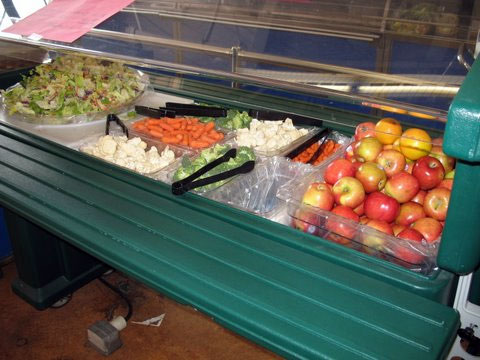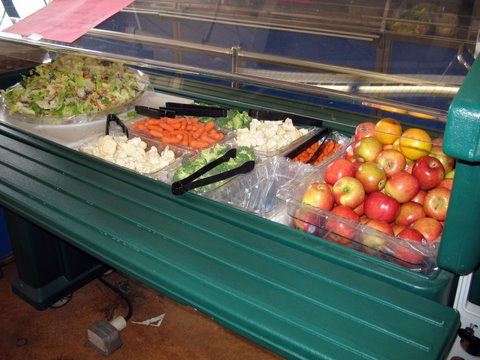 A salad bar at a San Francisco public school.Photo: BernalKCThe federal government runs a program ostensibly designed to ensure that every child has access to a healthy lunch each day they’re at school.
A salad bar at a San Francisco public school.Photo: BernalKCThe federal government runs a program ostensibly designed to ensure that every child has access to a healthy lunch each day they’re at school.
Unhappily, the program is so poorly funded that public schools have been forced to outsource lunches to the processed-food industry, which takes the opportunity to educate young palates on the wonders of dishes like “dinosaur nuggets.” More unfortunately still, the school-food legislation currently knocking around Congress would do little to shake things up; the bills add about a nickel to the approximately 90 cents per day schools have to spend on ingredients for each kids’ meal — not even enough for an extra apple a day.
Nor would the bills do anything to bolster the crumbling state of school-kitchen infrastructure. Under current conditions, schools have to generate their own funds to equip their kitchens — and that’s why most school have simply shut them down, relying increasingly on heat-and-serve fare instead of from-scratch cooking.
Responding to this seemingly intractable failure of public policy, long-time school lunch advocate Ann Cooper has launched the “Great American Salad Bar Project,” an effort to raise private money to equip schools with salad bars. Cooper’s first partner in the effort is Whole Foods, which has been hitting up customers at its stores across the country to donate money to the project. So far, Whole Foods has raised $1.4 million, which the Salad Bar Project will use to set up salad bars (worth about $2,500 each) for 300 schools nationwide. (In addition to the rolling food station, preparation and serving gear, the program also provides training materials to cafeteria staff on how to run a successful salad bar program.)
It’s important to note that the program will not solve the lunch problem for the 300 schools that win salad bars. The program doesn’t provide funding to buy any higher-quality food; the winning schools will be operating under the same budgetary crunch as before. On its website, the Salad Bar Project provides this helpful advice to administrators considering applying for a grant:
Implementing a Salad Bar in your school is one of the fastest ways to create fresh food access to all students purchasing a reimbursable meal. In fact the “salad” can be much more than greens and fruit. By utilizing USDA Commodity brown box items like diced chicken, tuna, egg products and grain products the Salad Bar reinvents itself as a reimbursable meal. Using the bar to introduce children to food in their raw state and educate students palates by offering some special seasonal salads makes fast work of transforming your cafeteria into a classroom enjoyed by all every day.
In other words, they’ll be serving up more or less the same food, hopefully augmented by fresh fruits and veggies. Limits aside, the bars undeniably amount to an important investment in infrastructure for steering kids to make healthier choices.
One catch: to be eligible for the bars, schools need to be within 50 miles of a Whole Foods outlet. Now, there are plenty of under-resourced schools that fit the bill — neighborhoods like New York City’s South Bronx or Chicago’s South Side, just a train ride ride from Whole Foods outlets in posh neighborhoods, will be able to apply. Even inner-city Detroit, perhaps the nation’s most notorious “food desert,” lies just 22 miles from the Whole Foods in Troy, Mich.
However, thousands of schools in rural areas across the country lack access to much high-quality food and don’t have funds to invest in infrastructure like salad bars to deliver it, but aren’t situated within 50 miles of a Whole Foods. For example, I don’t think the rural Illinois school where the anonymous blogger Mrs. Q teaches meets that standard. Mrs. Q’s daily dispatches from the cafeteria front lines expose the nutritional bankruptcy of the school lunch program. Everything served in Mrs. Q’s cafeteria comes on Styrofoam, shrink-wrapped in plastic (for a chilling photographic sampling of the school’s offerings, go here). Her school could clearly use a salad bar offering fresh, unwrapped food.
But to me, these limitations aren’t a knock against Cooper’s effort, or even on Whole Foods. Instead, they indict a political system that has lost its ability to accept the civic responsibility for providing a decent public education — which, I insist, includes a healthy, palatable lunch for each kid. And when the public sector fails, we can’t be too picky when the private sector and philanthropy move in to fill the void. As a publicly traded company, Whole Foods has the legal obligation to maximize profit for its shareholders. No wonder it imposed the 50-mile-radius stipulation on the fundraising effort; it likely wants its customers to be able to see its charitable activities as a way to build brand loyalty.
Cooper aims to expand her salad-bar fundraising push beyond Whole Foods to other donors. In lieu of public commitment of funds, those donors will likely be corporate entities — and many of them, too, will likely set conditions that serve their business interests. That’s the price we pay when we rely on private charity to step in when the public sector falters.
Because of course, charity can’t really fill the void. Even if Cooper managed to place a salad bar in every school in every low-income district — and I hope she does — we’d still have to invest significantly more public money in school lunches if we want those shiny new salad bars to provide food that’s any healthier than what they currently offer.




